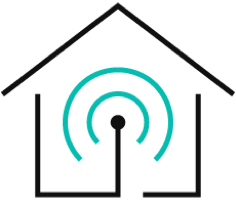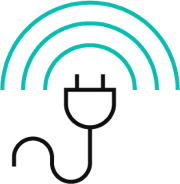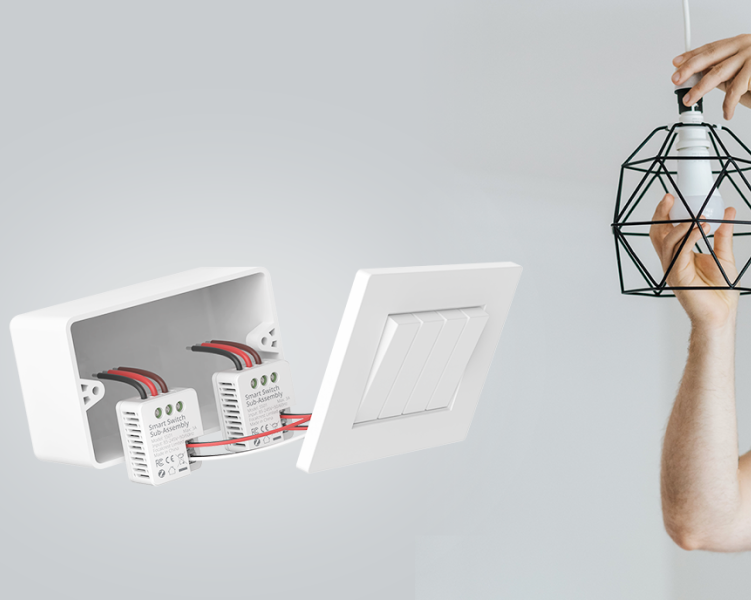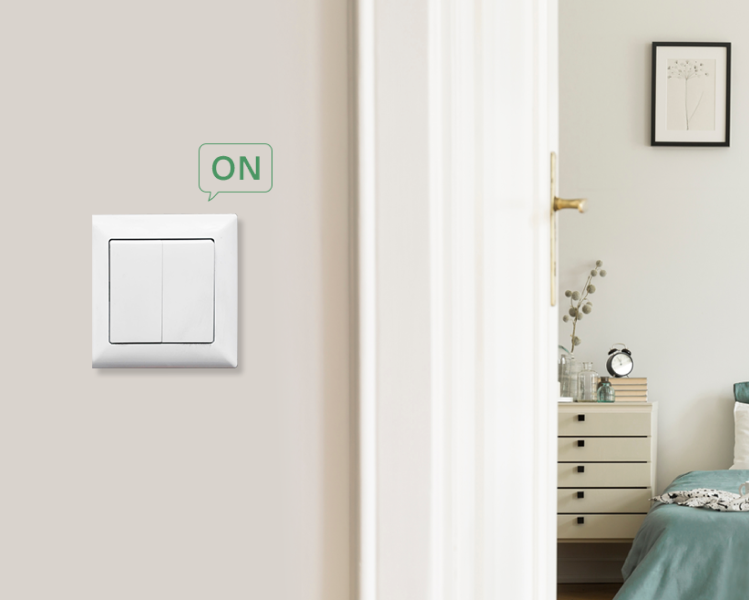Nowadays, people lean towards smart lighting or use a wireless light switch while building a new home or updating the lighting system of the older one. It's because smart lights bring you convenience at a low cost and open ways for home automation. However, there are so many options available in the market, like smart bulbs, smart switches, and in-wall smart relay switches, that make it very difficult for people to select the best smart lighting solution.
If you are also in a similar situation and want to get details of each smart lighting option before making any decision, we got you covered. Let's discuss a smart bulb, wireless smart switch, and in-wall smart relay switch, along with their features, benefits, and uses.
- Smart Bulb vs Smart Switch: What is Smart Bulb?
- Smart Bulb vs Smart Switch: What is a Smart Light Switch?
- Recommandation: In-Wall Smart Relay Switch
Smart Bulb vs Smart Switch: What is Smart Bulb?
A smart bulb resembles a simple LED bulb, but it is controlled using smart devices or technology. Smart light bulbs are expensive compared to traditional bulbs; however, they require less energy and serve you in the long run. As these bulbs use wireless communication such as ZigBee, Z-Wave, or Bluetooth for working, you can efficiently operate them through your smartphone, tablet, or any other tech device.
Smart bulbs come in various sizes and color-changing features, so you can pick the one that perfectly blends with your indoors. However, like many other smart home automation devices, smart light bulbs also have advantages and disadvantages. Let's discuss them in detail to help you understand whether smart light bulbs suit you!

Advantages of Smart Light Bulbs
Here are the advantages of installing smart light bulbs in your home:
Easy Operation
Compared to many other innovative lighting solutions or devices, a smart light bulb is very easy to operate. There's no need for complicated connectivity and installation, as you can use competent assistance or a smartphone app to run the bulb. Once you've installed the bulb, you can pair it up with your wireless internet connection.
After a successful connection, it gets easy for you to control it through your phone or voice control. However, if you have bought a specific brand of the smart light bulb, then it may need a particular gateway or hub. For instance, if you've just got your hands on a Philips Hue smart bulb, you need a Philips Hue Bridge for its successful operation.
>> Best WiFi Smart Light Bulbs for 2023
Longer Life Span
Typically, an incandescent bulb has an average lifespan of 750 to 2000 hours. But, as smart bulbs are either LED or CFL bulbs with integrated smart technology, their lifespan comprises over 350000 to 50000 hours. This means once you've installed smart light bulbs in your home, you can use them for as long as 20 years which is a lot more than the cost.
Better Security
Another benefit of smart light bulbs is that they make your home more secure. A smart bulb has sensors that detect the presence of someone in your room and gets turned on and off automatically. You can also use this feature to send alarms on your phone when you are away from home to ensure no one's entering your space.
Disadvantages of Smart Light Bulbs
Let's have a look at a few of the smart light bulbs disadvantages:
Needs Bridge for Higher Demands
If your smart light bulb usage is more than average or you need high voltage output, it'll not work with ordinary hubs or devices. Instead, you need to buy a separate bridge to meet the higher lighting demands of your home.
Light Switches Must be On
To operate your smart light bulb, it's essential to keep the light switch connected to it always on. It's because once you turn the switch off, you won't be able to operate the bulb through any smart device.
So, if you are looking for something to minimize your light and energy usage, a bright light bulb is the ultimate choice. It allows people to control the device through different options like manual or voice control and is a perfect smart home lighting package for those who want something easy-to-use and long-lasting.
Smart Bulb vs Smart Switch: What is a Smart Light Switch?
A smart light switch is also a wireless-enabled smart device that allows you to remotely control your home lights. It looks like a standard light switch but has many advanced features like you can control the lighting using your smart device or a voice command. Besides lights, an intelligent switch allows you to manage all other devices or equipment connected to it.
For instance, if the wireless light switch is connected to the fan or fireplace and lights in the same room, you can turn them on remotely through that switch. What's the best part? A wireless light switch lets you create custom schedules to turn it on and off at specific times. Moreover, with it, you can manually turn the switch on or off using a smartphone when away from home.

Advantages of Smart Light Switch
Here are the advantages of wireless light switches that you should know before it's installed in your home:
Very Convenient
A smart or wireless light switch is very convenient as you can control it anytime and anywhere as long as it has a steady internet connection. For instance, if you are out on vacation, you can schedule when you want your home lights to be on and off with your smartphone to save on your energy bills. This is something that you can't achieve with a traditional light switch.
Multi-Device Integration
As a wireless light switch is a quick way towards home automation, it enables you to control multiple devices remotely and manually. For instance, a smart switch turns on alarms, door sensors, and lighting before the arrival of homeowners.
Variety of Options
Another exciting advantage of the smart light switch is that it comes in various sizes and types. The main types are dimmer, motion sensors, rocker buttons, etc. So you can select the desired one matching your needs.
Disadvantages of a Smart or Wireless Light Switch
Just like many other home automation devices, a wireless light switch also has a few disadvantages that may make it an unsuitable option for you.
Need Upgradation
As a smart light switch needs a separate wire for installation, it's not ideal for old homeowners. You need to change the style of the home or wall before inserting this switch.
Need Different Models for Different Setup
To make your wireless light switch two-way or three-day, you need to go with a specific model. It's because not all switches are designed for multi-way operation. For example, if you want a 3-way smart light switch, then Lutron Caséta Wireless Smart Switch is a suitable option.
A wireless light switch is suitable for those who are either building a new home and want home automation or upgrading the old one. For old homeowners, it's not an ideal choice!
What is a In-Wall Smart Relay Switch?
Whether you are an old homeowner or building a new one, installing a in-wall smart relay switch is the best step towards home automation and control your home lighting. This switch has two parts: a smart relay part and a smart switch part. Connect it with HomeKit WiFi or use any hub like ZigBee or Z-wave to manage all your smart devices and appliances.
The most prominent examples of these devices are smart thermostats, smart security devices, smart kitchen appliances, etc. Moreover, all types of bulbs also work with this smart relay switch, but there's a flickering issue when connected to a low-power lamp.

Advantages of EVVR In-Wall Smart Relay Switch
EVVR In-Wall Smart Relay Switch has its unique split-type design to avoid the installation, connection, and flickering problems that occur above.
Let's have a quick look at the different advantages of Smart Relay Switch and why it's the best home automation device:
Without pairing with the Smart Switch part, the Smart Relay performs as an independent device that adds wireless (Zigbee/Z-Wave) connectivities to your lights and turns regular light bulbs into smart controlled lights. And the Smart Switch is an optional add-on that connects the Smart Relay and your wall switches for expanded functionality.
Whether the physical wall switch is on or off, the power is constantly on at the Smart Relay for it to remain always connected and online, thus you can always access and control your connected lights via apps or voice commands like Google Assistant, Alexa, Siri wirelessly.
No Neutral Wire Required
With this in-wall smart relay switch, you don't need a neutral wire for installation. With its exceptionally small size of smart switch part, insert it into your existing electrical boxes and get complete control over your appliances without having to rewire any existing walls or ceilings, so it won't affect your existing design.
Works with All Switches
The smart relay switch works perfectly with all types of controls. Whether you have a toggle switch or a momentary switch, there's no need to replace them to install the new relay switch.
Always connected, always online
Unlike other smart relay switches and smart bulbs, the Smart Relay part remains connected even if the wall switch is turned off. You can always access and control your lighting system via apps or voice commands like Google Assistant, Alexa and HomeKit Siri wirelessly.
Supports 3-Way and 4-Way Switches
This relay switch supports multiple-way transformation like 3-way or 4-way with your existing switches. You can control smart light fixtures from multiple conventional wall switches and various light fixtures from one location.
Disadvantages of Smart or Wireless In-Wall Relay Switch
The following are the disadvantages of smart relay switches:
Fewer Options Available
Although a smart in-wall relay switch is a versatile home automation device, there are few options available for this switch, and with a single live wire, there are only one or two choices for you.
If you need suggestions, EVVR is the best option as it has three different versions of this smart in-wall relay switch, such as Homekit, ZigBee, Z-Wave, etc. If you have an Apple device or a ZigBee hub, this switch will work smoothly with both.
It works with live wire and is comparatively small compared to other modules of the same category. There is no minimum load requirement, and it suits almost all types of bulbs like incandescent, halogen, LED, etc. You can operate the EVVR in-wall relay switch using Alexa, Siri with HomeKit version, Google Voice Assistant, etc. So, don't wait and make your home smart with this EVVR in-wall relay switch.
The wireless in-wall relay switch is the best device for performing multiple tasks, from adjusting lights to controlling different appliances with a simple touch or voice control. It has a minimal size and doesn't require a neutral wire, making it the most fantastic choice for old homeowners who are looking for a home automation solution.
Conclusion
Upgrading your home lighting system can be very easy if you know the needs of your home and whether the selected device has enough features to cater to them. If you only want minimal smart touch, then a smart light bulb is a good option to open ways for home automation. However, if you are upgrading or building a new home, then the smart wireless light switch is an ideal solution, but it needs different models for different switch set up.
The smart in-wall relay switch is the best option for those who don't want to disturb their home's decoration and want something smart and classy to make appliances easy to control. It's available in three versions and allows you to make a 3-way and 4-way switch which perfectly blends with your indoors. EVVR in-wall relay switch is best in this regard as it's small in size and offers you all the essential features to streamline the automation of your home. So, don't wait and grab yours now!















